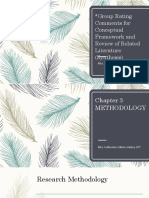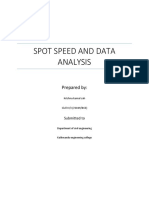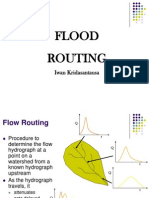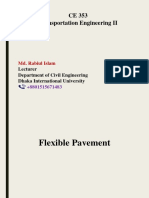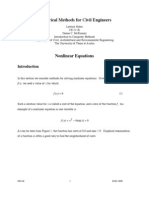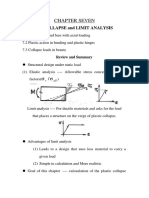Spot Speed PDF
Spot Speed PDF
Uploaded by
রাগীব শুভCopyright:
Available Formats
Spot Speed PDF
Spot Speed PDF
Uploaded by
রাগীব শুভOriginal Title
Copyright
Available Formats
Share this document
Did you find this document useful?
Is this content inappropriate?
Copyright:
Available Formats
Spot Speed PDF
Spot Speed PDF
Uploaded by
রাগীব শুভCopyright:
Available Formats
Transportation Systems Engineering 6.
Measurement over a Short Section
Chapter 6
Measurement over a Short Section
6.1 Overview
The main purpose of this chapter is to determine traffic parameter, specially speed. Speed
measurements are most often taken at a point (or a short section) of road way under conditions
of free flow. The intent is to determine the speeds that drivers select, unaffected by the existence
of congestion. This information is used to determine general speed trends, to help determine
reasonable speed limits, and to assess safety.
6.2 Speed Studies
As speed defines the distance travelled by user in a given time, and this is a vibrant in every
traffic movement. In other words speed of movement is the ratio of distance travelled to time
of travel. The actual speed of traffic flow over a given route may fluctuated widely, as because
at each time the volume of traffic varies. Accordingly, speeds are generally classified into three
main categories
1. Spot speed This is the instantaneous speed of a vehicle at any specific location.
2. Running speed This is the average speed maintained over a particular course while the
vehicle is in the motion.
3. Journey speed This is the effective speed of the vehicle on a journey between two points
and the distance between two points and the distance between these points divided by
the total time taken for the vehicle to complete the journey, it includes all delay.
Dr. Tom V. Mathew, IIT Bombay 6.1 February 19, 2014
Transportation Systems Engineering 6. Measurement over a Short Section
Stream Speed Length
below 15 30
15 -25 60
above 25 90
6.3 Spot Speed Studies
When we measure the traffic parameter over a short distance, we generally measure the spot
speed. A spot speed is made by measuring the individual speeds of a sample of the vehicle
passing a given spot on a street or highway. Spot speed studies are used to determine the speed
distribution of a traffic stream at a specific location. The data gathered in spot speed studies
are used to determine vehicle speed percentiles, which are useful in making many speed-related
decisions. Spot speed data have a number of safety applications, including the following
1. Speed trends,
2. Traffic control planning,
3. Accidental analysis,
4. Geometric design,
5. Research studies.
6.4 Methods of Measurement
Methods of conducting spot speed Studies are divided into two main categories: Manual and
Automatic. Spot speeds may be estimated by manually measuring the time it takes a vehicle
to travel between two defined points on the roadway a known distance apart (short distance),
usually less than 90m. Distance between two points is generally depending upon the average
speed of traffic stream. Following tables gives recommended study length (in meters) for various
average stream speed ranges (in kmph) Following are the some methods to measure spot speed
of vehicles in a traffic stream, in which first two are manual methods and other are automatic:
6.4.1 Pavement markings
In this method, markings of pavement are placed across the road at each end of trap. Observer
start and stops the watch as vehicle passes lines. In this method, minimum two observers
Dr. Tom V. Mathew, IIT Bombay 6.2 February 19, 2014
Transportation Systems Engineering 6. Measurement over a Short Section
required to collect the data, of which one is stand at the starting point to start and stop the
stop watch and other one is stand at end point to give indication to stop the watch when vehicle
passes the end line. Advantages of this method are that after the initial installation no set-up
time is required, markings are easily renewed, and disadvantage of this is that substantial error
can be introduced, and magnitude of error may change for substitute studies and this method
is only applicable for low traffic conditions.
Vertical Reference
point Vertical Reference
End Timing point
Study length
Approaching Vehicle
Start timing
Observer 2 Observer 1
X
Figure 6:1: Pavement Marking
6.4.2 Enoscope or Mirror box
Enoscope consists of a simple open housing containing a mirror mounted on a tripod at the
side of the road in such a way that an observer’s line of sight turned through 90o. The observer
stands at one end of section and on the other end enoscope is placed and measure the time
taken by the vehicle to cross the section (fig 6.2). Advantages of this method are that it simple
and eliminate the errors due to parallax and considerable time is required to time each vehicle,
which lengthen the study period and under heavy traffic condition it may be difficult to relate
ostentatious to proper vehicle are the disadvantages of enoscope method.
6.4.3 Road Detector (Pressure contact strips)
Pressure contact strips, either pneumatic or electric, can be used to avoid error due to parallax
and due to manually starting and stopping the chronometer or stopwatch. This is the best
method over short distance it gives quite relevant data and if it is connected through graphical
recorder then it gives continuous data automatically.
Dr. Tom V. Mathew, IIT Bombay 6.3 February 19, 2014
Transportation Systems Engineering 6. Measurement over a Short Section
x
observer enoscope
Base length
Figure 6:2: Enoscope Method
6.4.4 Doppler-Principle Meters (Radar)
This is recently developed method, it automatically records speed, employs a radar transmitter-
receiver unit. The apparatus transmits high frequency electromagnetic waves in a narrow beam
towards the moving vehicle, and reflected waves changed their length depending up on the
vehicles speed and returned to the receiving unit, through calibration gives directly spot speed
of the vehicle.
6.4.5 Electronic-Principle Detectors (Photography)
In this method a camera records the distance moved by a vehicle in a selected short time. In this
exposure of photograph should be in a constant time interval and the distance travelled by the
vehicle is measured by projecting the films during the exposure interval. The main advantage
of method that, it gives a permanent record with 100% sample obtained. This method is quite
expensive and generally used in developed cities. In this we can use video recorder which give
more accurate result.
6.5 Data Collection Sheets
The measured data by the above techniques should be collected into some formats, following
are the some types of data collection sheets which are used for manual and automatic methods,
1. For Enoscope and Pavement Marking Methods
2. For automatic methods
Dr. Tom V. Mathew, IIT Bombay 6.4 February 19, 2014
Transportation Systems Engineering 6. Measurement over a Short Section
Location: Date:
Weather: Time:
Type of road: Base Length:
Measurement Technique:
TIME TAKEN (in sec)
S NO.
Car/jeep 3 Wheeler 2 Wheeler Cycle LCV HCV
1
7
8
9
10
Surveyor:
Figure 6:3: Data collection sheet for Enoscope and Pavement Marking Methods
Spot Speed Data Collection Form
Location: Data:
Time:
Weather:
Measurement Technique:
Type of road:
Vehicle No. Speed Vehicle No. Speed
Surveyor:
Spot Speed Data Collection Form
Location: Date:
Weather: Time:
Type of road: Base Length:
Measurement Technique:
Speed Range Tally Mark Number
Total
in kmph Car/Jeep Bus/Truck Car/Jeep Bus/Truck
0 5
5 10
10 15
15 20
20 25
25 30
30 35
35 40
40 45
45 50
50 55
55 60
60 65
Surveyor:
Figure 6:4: Data collection sheet for Automatic Methods
6.6 Data Presentation
From the above methods, the collected data have to present into the some representable form,
this makes its calculation and analysis simpler and easier. The following methods to present
the spot speed data:
Dr. Tom V. Mathew, IIT Bombay 6.5 February 19, 2014
Transportation Systems Engineering 6. Measurement over a Short Section
6.6.1 Frequency Distribution Table
After the collection of data in the given conditions, arrange the spot speed values in order to
their magnitudes. Then select an interval speed (e.g. 5 kmph) and make grouping of data
which come under this range. Now, prepare the frequency distribution table.
6.6.2 Frequency Distribution Curve
For each speed group, the % frequency of observations within the group is plotted versus the
middle (mid-mark) speed of the group(s). As shown in Fig 6.5. From this curve the modal
speed and pace of traffic flow can be determine. Generally the shape of the curve follows the
normal distribution curve, this because the most of the vehicles move on road near by mean
speed and very few deviate from mean speed.
6.6.3 Cumulative Frequency Distribution Curve
For each speed group, the % cumulative frequency of observations is plotted versus the higher
limit of the speed group (Fig 6.5). The cumulative frequency distribution curve, however,
results in a very useful plot of speed versus the percent of vehicles traveling at or below the
designated speed. For this reason, the upper limit of the speed group is used as the plotting
point. In both the distribution curve, the plots are connected by a smooth curve that minimizes
the total distance of points falling above the line and those falling below the line. A smooth
curve is defined as one without.
6.7 Distribution Characteristics
Common descriptive statistics may be computed from the data in the frequency distribution ta-
ble or determined graphically from the frequency and cumulative frequency distribution curves.
These statistics are used to describe two important characteristics of the distribution:
6.7.1 Measure of Central Tendency
Measure which helps to describe the approximate middle or center of the distribution. Measures
of central tendency include the average or mean speed, the median speed, the modal speed,
and the pace.
Dr. Tom V. Mathew, IIT Bombay 6.6 February 19, 2014
Transportation Systems Engineering 6. Measurement over a Short Section
25
Mode
$\% Frequency
20
15
Pace
10
0
32 36 40 44 48 52 56 60 64 Speed
100 (kph)
$Cum.\%freq$
90
80 $86\%$
70
60 $\% Veh in pace =86−14= 72\%$
50 Median
40
30
20 $14\%$
10
0 Speed
32 36 40 44 48 52 56 60 64 (kph)
Figure 6:5: Frequency and Cumulative Frequency Distribution curve
Mean Speed
The arithmetic (or harmonic) average speed is the most frequently used speed statistics. It is
the measure of central tendency of the data. Mean calculated gives two kinds of mean speeds.
Σfi vi
vt = (6.1)
n
where, vt is the mean or average speed, vi is the individual speed of the ith vehicle, fi is the
frequency of speed, and n is the total no of vehicle observed (sample size). Time mean Speed
If data collected at a point over a period of time, e.g. by radar meter or stopwatch, produce
speed distribution over time, so the mean of speed is time mean speed. Space mean Speed
If data obtained over a stretch (section) of road almost instantaneously, aerial photography or
enoscope, result in speed distribution in space and mean is space mean speed. Distribution
over space and time are not same. Time mean speed is higher than the space mean speed. The
spot speed sample at one end taken over a finite period of time will tend to include some fast
vehicles which had not yet entered the section at the start of the survey, but will exclude some
of the slower vehicles. The relationship between the two mean speeds is expressed by:
σs2
vt = vs + (6.2)
vs
where, vt and vs are the time mean speed and space mean speed respectively. And σs is the
standard deviation of distribution space.
Median Speed
The median speed is defined as the speed that divides the distribution in to equal parts (i.e.,
there are as many observations of speeds higher than the median as there are lower than
Dr. Tom V. Mathew, IIT Bombay 6.7 February 19, 2014
Transportation Systems Engineering 6. Measurement over a Short Section
the median). It is a positional value and is not affected by the absolute value of extreme
observations. By definition, the median equally divides the distribution. Therefore, 50% of all
observed speeds should be less than the median. In the cumulative frequency curve, the 50th
percentile speed is the median of the speed distribution. Median Speed = v50
Pace
The pace is a traffic engineering measure not commonly used for other statistical analyses. It is
defined as the 10Km/h increment in speed in which the highest percentage of drivers is observed.
It is also found graphically using the frequency distribution curve. As shown in fig 6.5. The
pace is found as follows: A 10 Km/h template is scaled from the horizontal axis. Keeping this
template horizontal, place an end on the lower left side of the curve and move slowly along the
curve. When the right side of the template intersects the right side of the curve, the pace has
been located. This procedure identifies the 10 Km/h increments that intersect the peak of the
curve; this contains the most area and, therefore, the highest percentage of vehicles.
Modal Speed
The mode is defined as the single value of speed that is most likely to occur. As no discrete values
were recorded, the modal speed is also determined graphically from the frequency distribution
curve. A vertical line is dropped from the peak of the curve, with the result found on the
horizontal axis.
6.7.2 Measure of Dispersion
Measures describe the extent to which data spreads around the center of the distribution.
Measures of dispersion include the different percentile speeds i.e. 15th, 85th,etc. and the
standard deviation.
Standard Deviation
The most common statistical measure of dispersion in a distribution is the standard deviation.
It is a measure of how far data spreads around the mean value. In simple terms, the standard
deviation is the average value of the difference between individual observations and the average
value of those observations. The Standard deviation, σs , of the sample can be calculated by
r
Σfi (vi − vv )2
σs = (6.3)
n−1
Dr. Tom V. Mathew, IIT Bombay 6.8 February 19, 2014
Transportation Systems Engineering 6. Measurement over a Short Section
Percentile Speeds
The 85th and 15th percentile speeds give a general description of the high and low speeds
observed by most reasonable drivers. It is generally thought that the upper and lower 15% of
the distribution represents speeds that are either too fast or too slow for existing conditions.
These values are found graphically from the cumulative frequency distribution curve of Figure
6.4. The curve is entered on the vertical axis at values of 85% and 15%. The respective speeds
are found on the horizontal axis. The 85th and 15th percentile speeds can be used to roughly
estimate the standard deviation of the distribution σest , although this is not recommended when
the data is available for a precise determination.
v85 − v15
σest = (6.4)
2
The 85th and 15th percentile speeds give insight to both the central tendency and dispersion of
the distribution. As these values get closer to the mean, less dispersion exists and the stronger
the central tendency of the distribution becomes.
The 98th percentile speed is also determining from the cumulative frequency curve, this
speed is generally used for geometric design of the road.
6.8 Data Analysis
6.8.1 Standard Error of the mean
The means of different sample taken from the same population are distributed normally about
the true mean of population with a standard deviation, is known as standard error.
σs
Se = √ (6.5)
n
6.8.2 Sample Size
Generally, sample sizes of 50 to 200 vehicles are taken. In that case, standard error of mean is
usually under the acceptable limit. If precision is prior then minimum no. of sample should be
taken, that can be measured by using the following equation.
Z 2 σs2
nr = (6.6)
Se2
where, nr is the no. of sample required, σs is the Standard deviation, Z is value calculated from
Standard Normal distribution Table for a particular confidence level (i.e. for 95% confidence
Z=1.96 and for 99.7% confidence Z=3.0) and Se is the permissible (acceptable) error in mean
calculation.
Dr. Tom V. Mathew, IIT Bombay 6.9 February 19, 2014
Transportation Systems Engineering 6. Measurement over a Short Section
6.8.3 Precision and Confidence Intervals
Confidence intervals express the range within which a result for the whole population would
occur for a particular proportion of times an experiment or test was repeated among a sample
of the population. Confidence interval is a standard way of articulate the statistical accuracy
of an experiment based assessment. If assess has a high error level, the equivalent confidence
interval will be ample, and the less confidence we can have that the experiment results depict
the situation among the whole population. When quoting confidence It is common to refer to
the some confidence interval around an experiment assessment or test result. So, the confidence
interval for estimated true mean speed can be calculated by
µ = vt ± Zσs (6.7)
where, µ is the confidence interval, vt is mean speed, σs is standard deviation and Z is constant
for specified confidence.
6.8.4 Numerical Example
Using the spot speed data given in the following table, collected from a freeway site operating
under free-flow conditions: (i) Plot the frequency and cumulative frequency curves for these
data; (ii) Obtain median speed, modal speed, pace, and percent vehicles in pace from these
plots; (iii) Compute the mean and standard deviation of the speed distribution; (iv) The
confidence bounds on the estimate of the true mean speed of the underlying distribution with
95% confidence? With 99.7% confidence; and (v) Based on these results, compute the sample
size needed to achieve a tolerance of ±1.5 kmph with 95% confidence.
Solution For the spot speed study, first draw a frequency distribution table show below.
1. From the table 6.3, we can draw frequency distribution and cumulative frequency distri-
bution curve.(shown in Fig 6.6 and 6.7)
2. From the curves, Median speed, v50 = 43 kmph; Modal speed, = 38 kmph; the Pace =
33 - 43 kmph; Percent vehicles in pace = 54-20= 34%; and the 85th Percentile speed =
58 kmph.
3. Mean is calculated by using
Σfi vi
vt =
n
5950
= = 45.77 kmph
130
Dr. Tom V. Mathew, IIT Bombay 6.10 February 19, 2014
Transportation Systems Engineering 6. Measurement over a Short Section
Speed Range Frequency fi
21-25 2
26-30 6
31-35 18
36-40 25
41-45 19
46-50 16
51-55 17
56-60 12
61-65 7
66-70 4
71-75 3
76-80 1
fi × (Vi − Vm )2
P
Speed Range Mid speed Vi Frequency fi % fi % fi fi × Vi
21-25 23 2 2% 2% 46 1036.876
26-30 28 6 5% 6% 168 1894.473
31-35 33 18 14% 20% 594 2934.959
36-40 38 25 19% 39% 950 1509.024
41-45 43 19 15% 54% 817 145.7041
46-50 48 16 12% 66% 768 79.6213
51-55 53 17 13% 79% 901 888.8284
56-60 58 12 9% 88% 696 1795.101
61-65 63 7 5% 94% 441 2078.296
66-70 68 4 3% 97% 272 1976.828
71-75 73 3 2% 99% 219 2224.544
76-80 78 1 1% 100% 78 1038.822
Total 130 100% 5950 17603.08
Table 6:1: Solution of the example problem
Dr. Tom V. Mathew, IIT Bombay 6.11 February 19, 2014
Transportation Systems Engineering 6. Measurement over a Short Section
25\%
20\%
Mode
Frequency(\%)
pace
15\%
10\%
5\%
0\%
33 38 43
0 10 20 30 40 50 60 70 80 90
Speed (kmph)
Figure 6:6: Frequency Distribution Curve
100\%
90\% $v_85$
85\%
80\%
cumulative frequency(\%)
70\%
60\%
$v_50$
50\%
40\%
30\%
20\%
$v_15$
15\%
10\%
32 43 58
0 10 20 30 40 50 60 70 80 90
Speed (kmph)
Figure 6:7: Cumulative Frequency Distribution Curve
Standard Deviation of the Speed
r
Σfi (vi − vt )2
σs =
n−1
r
17603.08
= = 11.7 kmph
130 − 1
4. The confidence bounds on the estimate of the true mean speed of the underlying distri-
bution are:
µ = vt ± Zσs
(a) For 95% confidence, Z= 1.96, so
µ = 45.77 ± 1.96 × 11.7 = 45.77 ± 22.93 kmph
(b) For 99.7% confidence, Z= 3.0, so
µ = 45.77 ± 3.0 × 11.7 = 45.77 ± 35.1 kmph
Dr. Tom V. Mathew, IIT Bombay 6.12 February 19, 2014
Transportation Systems Engineering 6. Measurement over a Short Section
Parameter Value
Median speed 43 kmph
Modal speed 38 kmph
Pace 33-43 kmph
Vehicles in pace 34%
Mean speed 45.77 kmph
Standard Deviation 11.7 kmph
85th percentile speed 58 kmph
15th percentile speed 32 kmph
98th percentile Speed 72 kmph
Confidence interval
For 95%. 45.7722.93 kmph
For 99.7% 45.7725.1 kmph
Required sample Size 234
Table 6:2: Result of the example problem
5. Sample size required for 95% confidence with acceptable error of 1.5 kmph
Z 2 σs2
nr =
Se2
1.962 × 11.72
= = 234.
1.52
So, given sample size is not sufficient and we require minimum 234 samples to achieve
that confidence with given acceptable error. The results are summaries in table 6.8.4
6.9 Location for Speed Studies
The speed studies are accompanied for eminently logical purposes that will influence what
traffic engineering measures are implemented in any given case. The location at which speed
measurements are taken must conform to the intentional purpose of the study. The guiding phi-
losophy behind spot speed studies is that measurements should include drivers freely selecting
their speeds, unaffected by traffic congestion. For example if driver approaches to a toll plaza,
then he has to slow his speed, so this is not suitable location to conduct the study, measure-
ments should be taken at a point before drivers start to decelerate. Similarly, if excessive speed
around a curve is thought to be contributing to off-the-road accidents, speed measurements
Dr. Tom V. Mathew, IIT Bombay 6.13 February 19, 2014
Transportation Systems Engineering 6. Measurement over a Short Section
should be taken in advance of the curve, before deceleration begins. It may also be appro-
priate, however, to measure speeds at the point where accidents are occurring for evaluation
with approach speeds. This would allow the traffic engineer to assess whether the problem is
excessive approach speed or that drivers are not decelerating sufficiently through the subject
geometric element, or a combination of both. A study of intersection approach speeds must
also be taken at a point before drivers begin to decelerate. This may be a moving point, given
that queues get shorter and longer at different periods of the day.
6.10 Summary
This chapter has presented the basic concepts of speed studies. Spot speed studies are conducted
to estimate the distribution of speeds of vehicle in the traffic stream at a particular position
on highway. This is done by recording the speeds of vehicle at the specified location. These
data are used to obtain speed characteristics such as mean speed, modal speed, pace, standard
deviation and different percentile of speeds. The important factors which should consider during
plan of studies is the location of study, time and duration of study. The data sample collected
should contain samples size. These gives precision and accuracy of result.
6.11 References
1. F D Hobbs. Traffic Planning and Engineering. Pergamon Press, 1979. 2nd Edition.
2. Nicholas J Garber Lester A Hoe. Traffic and Highway Engineering. Cengage Learning
Product, Fourth Edition, 2009.
3. Theodore M Matson, Wilbure S smith, and Fredric W Hurd. Traffic engineering, 1955.
4. R P Roess, S E Prassas, and W R McShane. Traffic Engineering. Pearson Education
International, 2005.
Dr. Tom V. Mathew, IIT Bombay 6.14 February 19, 2014
You might also like
- Guidelines For Reliability Based DesignDocument236 pagesGuidelines For Reliability Based DesignDiego100% (1)
- Sample Size-V3Document49 pagesSample Size-V3Munna KendreNo ratings yet
- Traffic Characterization PDFDocument11 pagesTraffic Characterization PDFAlejandro GonzalezNo ratings yet
- SQQS1013 Chapter 5Document23 pagesSQQS1013 Chapter 5Cyrilraincream100% (1)
- Chapter 3 Quantitative Research MethodologyDocument54 pagesChapter 3 Quantitative Research MethodologyClarence Dave T. TolentinoNo ratings yet
- Measurement of Spot Speed and Data AnalysisDocument10 pagesMeasurement of Spot Speed and Data AnalysisjacobNo ratings yet
- Calculation of Foundation Settlement and Coefficient of Soil Subgrade ReactionDocument10 pagesCalculation of Foundation Settlement and Coefficient of Soil Subgrade ReactionleodegarioporralNo ratings yet
- Chapter 5: Elements of Intersection Design and Layout Signal Timing and Design of IntersectionsDocument77 pagesChapter 5: Elements of Intersection Design and Layout Signal Timing and Design of Intersectionsmulabbi brianNo ratings yet
- Ecg 354 - Highway Engineering: The Report Must Be Submitted 1 Week After The Completion of The LabDocument10 pagesEcg 354 - Highway Engineering: The Report Must Be Submitted 1 Week After The Completion of The LabNurin Adlina100% (1)
- 15 Advanced HEC-RAS FeaturesDocument37 pages15 Advanced HEC-RAS FeaturesguidoxlNo ratings yet
- Road Note 31/ Catalogue MethodDocument29 pagesRoad Note 31/ Catalogue MethodDoughnut Chilli PiNo ratings yet
- Compiled Infrastructure Assignment KadduDocument25 pagesCompiled Infrastructure Assignment Kadduomonaedwin2No ratings yet
- Flood Routing - Dr. Iwan KridaDocument36 pagesFlood Routing - Dr. Iwan KridaNurina AnggrainiNo ratings yet
- A Chip Seal (Also Called A "Seal Coat") Is Essentially A Single Layer of Asphalt Binder That IsDocument24 pagesA Chip Seal (Also Called A "Seal Coat") Is Essentially A Single Layer of Asphalt Binder That IsHalmat GharibNo ratings yet
- Flexible Pavement DesignDocument33 pagesFlexible Pavement DesignLalith Koushik GanganapalliNo ratings yet
- Experiment: Torsion of A Spiral Spring: Vibrations LabDocument4 pagesExperiment: Torsion of A Spiral Spring: Vibrations LabVenkata DineshNo ratings yet
- Manual For Terrestrial Laser Scanner: July 2020Document15 pagesManual For Terrestrial Laser Scanner: July 2020AKi Asmoro SantoNo ratings yet
- Industrial Training PresentationDocument22 pagesIndustrial Training Presentationsachin palNo ratings yet
- CE 353 Transportation Engineering II: Md. Rabiul IslamDocument25 pagesCE 353 Transportation Engineering II: Md. Rabiul IslamMohamed Isak AliNo ratings yet
- VivaDocument76 pagesVivaRam NepaliNo ratings yet
- Light Rail Full PDFDocument139 pagesLight Rail Full PDFRajitha SamarakoonNo ratings yet
- Numerical Methods For Civil EngineersDocument24 pagesNumerical Methods For Civil EngineersbhargavgadhviNo ratings yet
- Soil ClassificationDocument25 pagesSoil ClassificationAslam KhanNo ratings yet
- Slope Case StudyDocument15 pagesSlope Case StudyKisshenrau Vijayan ArenaNo ratings yet
- Tugasan Individu No 1 Tall Bulding Construction 2 1920Document5 pagesTugasan Individu No 1 Tall Bulding Construction 2 1920EJ KooNo ratings yet
- GEO3701 Assessment 6 2021Document7 pagesGEO3701 Assessment 6 2021Tyburg R DhliwayoNo ratings yet
- Plastic Collapse PDFDocument13 pagesPlastic Collapse PDFrajashrismdNo ratings yet
- A Fresh Look at Bolted End Plate Behaviour and DesignDocument11 pagesA Fresh Look at Bolted End Plate Behaviour and DesignSulaim Al KautsarNo ratings yet
- Te Lab Shape of AggregateDocument8 pagesTe Lab Shape of AggregateShivpreet SharmaNo ratings yet
- Engineering Surveying Field Scheme ReportDocument6 pagesEngineering Surveying Field Scheme ReportMohafisto SofistoNo ratings yet
- Lect 3Document65 pagesLect 3Ajay KumarNo ratings yet
- 2.2 Grain Size Distribution: Sieve AnalysisDocument20 pages2.2 Grain Size Distribution: Sieve AnalysisYen Ling NgNo ratings yet
- Coherent Gravity I K StiffesDocument8 pagesCoherent Gravity I K Stiffesgrga piticNo ratings yet
- Chapter Five HytographDocument43 pagesChapter Five HytographJessy BandyaNo ratings yet
- Soil Stiffness Parameters Using DMTDocument8 pagesSoil Stiffness Parameters Using DMTMehdi.MostNo ratings yet
- Mahinda Rajapaksa International Stadium HomagamaDocument6 pagesMahinda Rajapaksa International Stadium HomagamaMuhammadh MA100% (1)
- Spesifikasi Teknis Steel Sheet Pile: U TypeDocument1 pageSpesifikasi Teknis Steel Sheet Pile: U TypebagusNo ratings yet
- Design Review Report For Kazwama - Kyalukuza RoadDocument8 pagesDesign Review Report For Kazwama - Kyalukuza RoadhaumbamilNo ratings yet
- Basics of Limit State Method LSM 1 RCCDocument12 pagesBasics of Limit State Method LSM 1 RCCDrGanesh KameNo ratings yet
- Soil Investigation Report & RecomendationsDocument35 pagesSoil Investigation Report & RecomendationsmadhuNo ratings yet
- Chapter 1 Electronic Distance Measurement-1Document24 pagesChapter 1 Electronic Distance Measurement-1Amir Alisty0% (1)
- Traffic Flow RelationshipsDocument2 pagesTraffic Flow RelationshipsKarla Bovell100% (1)
- ECE 4215 Pavement Analysis Design Worked ExamplesDocument8 pagesECE 4215 Pavement Analysis Design Worked ExamplesdantezNo ratings yet
- Distance Learning Assignment ProjectDocument28 pagesDistance Learning Assignment ProjectFaisal SattiNo ratings yet
- STRUCTURAL PRESENTATION IDP Final YearDocument16 pagesSTRUCTURAL PRESENTATION IDP Final YearNorfarisha AqilaNo ratings yet
- Bridges Engineering Assignment: Topic: Long Span BridgesDocument9 pagesBridges Engineering Assignment: Topic: Long Span Bridgeskheiriya duskiNo ratings yet
- Numericals:: 1300 4740 E Ti/ti 4740/1300 3.646Document36 pagesNumericals:: 1300 4740 E Ti/ti 4740/1300 3.646Vijay MNo ratings yet
- Pile Load Capacity-Cohesion Less Soils-Lec-2Document13 pagesPile Load Capacity-Cohesion Less Soils-Lec-2Zahoor AhmadNo ratings yet
- Assessment of Building Failures in Kenya-Nairobi Case StudyDocument87 pagesAssessment of Building Failures in Kenya-Nairobi Case StudyWuod ElizaNo ratings yet
- Diverging and Merging Auxiliary Lanes and TapersDocument11 pagesDiverging and Merging Auxiliary Lanes and TapersBalaji NaikNo ratings yet
- Roads in Desert, Swamp & Black Cotton SoilDocument20 pagesRoads in Desert, Swamp & Black Cotton SoilSeif EddineNo ratings yet
- CADS - M Dense Sand Unreinforced Phi 40Document2 pagesCADS - M Dense Sand Unreinforced Phi 40DavidNo ratings yet
- S2-Finite Element Analysis For Geomechanics (516) .Text - MarkedDocument2 pagesS2-Finite Element Analysis For Geomechanics (516) .Text - MarkedHari RamNo ratings yet
- Cube TestDocument10 pagesCube Testridhuanzainal100% (1)
- Transition Curves in Road DesignDocument31 pagesTransition Curves in Road DesignjamilthaljiNo ratings yet
- 3A Pavement MaterialsDocument19 pages3A Pavement MaterialsKwasi Agyeman-BoakyeNo ratings yet
- Lec#4 Horizontal AlignmentDocument76 pagesLec#4 Horizontal AlignmentUsama AliNo ratings yet
- Buckingham PieDocument19 pagesBuckingham PiePunit GwalaniNo ratings yet
- Design of RotaryDocument39 pagesDesign of RotarySunilAjmeeraNo ratings yet
- Topic: Speed Survey (Spot Speed Survey)Document25 pagesTopic: Speed Survey (Spot Speed Survey)Sanjay KumarNo ratings yet
- Speed Studies 1Document15 pagesSpeed Studies 1tamsacheson_r1431No ratings yet
- Transport2 SpotspeedDocument13 pagesTransport2 SpotspeedSymon PokharelNo ratings yet
- Sample Size Determination PDFDocument28 pagesSample Size Determination PDFVedanti Gandhi100% (1)
- Homogeneity in Pharmaceutical Mixing ProcessesDocument10 pagesHomogeneity in Pharmaceutical Mixing ProcessesRichard AndersonNo ratings yet
- Statistics - Probability - Q3 - Mod6 - Central Limit TheoremDocument24 pagesStatistics - Probability - Q3 - Mod6 - Central Limit TheoremSheebei Sheebei78% (27)
- Interpretation and Data AnalysisDocument20 pagesInterpretation and Data AnalysisPinkam Jangid50% (2)
- 1 s2.0 S2773139122000039 MainDocument11 pages1 s2.0 S2773139122000039 MainlaythsalmsnNo ratings yet
- QTM C3Document9 pagesQTM C3Shashwat JhaNo ratings yet
- SOP-4 BDocument7 pagesSOP-4 BAntonio Jeremiah TurzarNo ratings yet
- Chapter 7 Inferences Using Normal and T-DistributionDocument16 pagesChapter 7 Inferences Using Normal and T-Distributionmenglee100% (1)
- Traffic Data AnalysisDocument4 pagesTraffic Data AnalysisRachelle C. AbanesNo ratings yet
- Bab III Integral GandaDocument396 pagesBab III Integral GandaMessy CoolNo ratings yet
- Xtraex 03Document4 pagesXtraex 03friendlylionNo ratings yet
- Baseline Report For: JANUARY 1, 2018Document22 pagesBaseline Report For: JANUARY 1, 2018Fazle RabbaniNo ratings yet
- Chapter4 Sampling Stratified SamplingDocument43 pagesChapter4 Sampling Stratified SamplingShourjyo biswasNo ratings yet
- UL (Inferences From Two Samples) - SalvaDocument75 pagesUL (Inferences From Two Samples) - SalvaLizette Leah ChingNo ratings yet
- 13 - Chapter 3Document22 pages13 - Chapter 3manoj varmaNo ratings yet
- SAP 001-Futility Analysis Alzheimer'sDocument71 pagesSAP 001-Futility Analysis Alzheimer'schunyuanfeiNo ratings yet
- Tel./Fax No. (047) 602 1391 E-Mail Address: Zambales@deped - Gov.ph Website: WWW - Depedzambales.phDocument15 pagesTel./Fax No. (047) 602 1391 E-Mail Address: Zambales@deped - Gov.ph Website: WWW - Depedzambales.phMlynNo ratings yet
- 03 Chapter 3 - Statistical EstimationDocument17 pages03 Chapter 3 - Statistical EstimationYohanna SisayNo ratings yet
- Guide To Clinical Trial Protocol Content and FormatDocument8 pagesGuide To Clinical Trial Protocol Content and FormatRohit Manakchand ZawarNo ratings yet
- Chap 007Document60 pagesChap 007Jeanelle AbadillaNo ratings yet
- 7B.2 IvyLearn - Last Homework Polls and Margin of Error - 2HH-Fall 2023-Quantitative ReasoningDocument1 page7B.2 IvyLearn - Last Homework Polls and Margin of Error - 2HH-Fall 2023-Quantitative Reasoningmaximogreen2003No ratings yet
- Experiments Montgomery WordDocument111 pagesExperiments Montgomery WordRendi AlexandriaNo ratings yet
- 09 Sampling DistributionDocument15 pages09 Sampling DistributionMuhammad AbdullahNo ratings yet
- 07-03-2019 CaiibDocument5 pages07-03-2019 Caiibjay meskaNo ratings yet
- The State of Entrepreneurship Education in Public Senior Secondary Schools in Rivers State of NigeriaDocument8 pagesThe State of Entrepreneurship Education in Public Senior Secondary Schools in Rivers State of NigeriaResearch ParkNo ratings yet
- Chapter 1 To 5 For Printing.2Document86 pagesChapter 1 To 5 For Printing.2Senku ishigamiNo ratings yet




